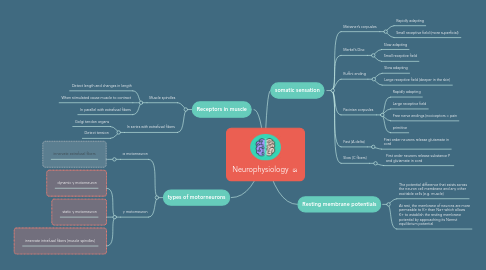Neurophysiology
by Udi h Bauman


1. Receptors in muscle
1.1. Muscle spindles
1.1.1. Detect length and changes in length
1.1.2. When stimulated cause muscle to contract
1.1.3. In parallel with extrafusal fibers
1.2. In series with extrafusal fibers
1.2.1. Golgi tendon organs
1.2.2. Detect tension
2. types of motorneurons
2.1. α motorneuron
2.1.1. innervate extrafusal fibers
2.2. γ motorneuron
2.2.1. dynamic γ motorneuron
2.2.2. static γ motorneuron
2.2.3. innervate intrafusal fibers (muscle spindles)
3. somatic sensation
3.1. Meissner’s corpusles
3.1.1. Rapidly adapting
3.1.2. Small receptive field (more superficial)
3.2. Merkel’s Disc
3.2.1. Slow adapting
3.2.2. Small receptive field
3.3. Ruffini ending
3.3.1. Slow adapting
3.3.2. Large receptive field (deeper in the skin)
3.4. Pacinian corpusles
3.4.1. Rapidly adapting
3.4.2. Large receptive field
3.4.3. Free nerve endings (nociceptors = pain
3.4.4. primitive
3.5. Fast (A delta)
3.5.1. First order neurons release glutamate in cord
3.6. Slow (C fibers)
3.6.1. First order neurons release substance P and glutamate in cord
